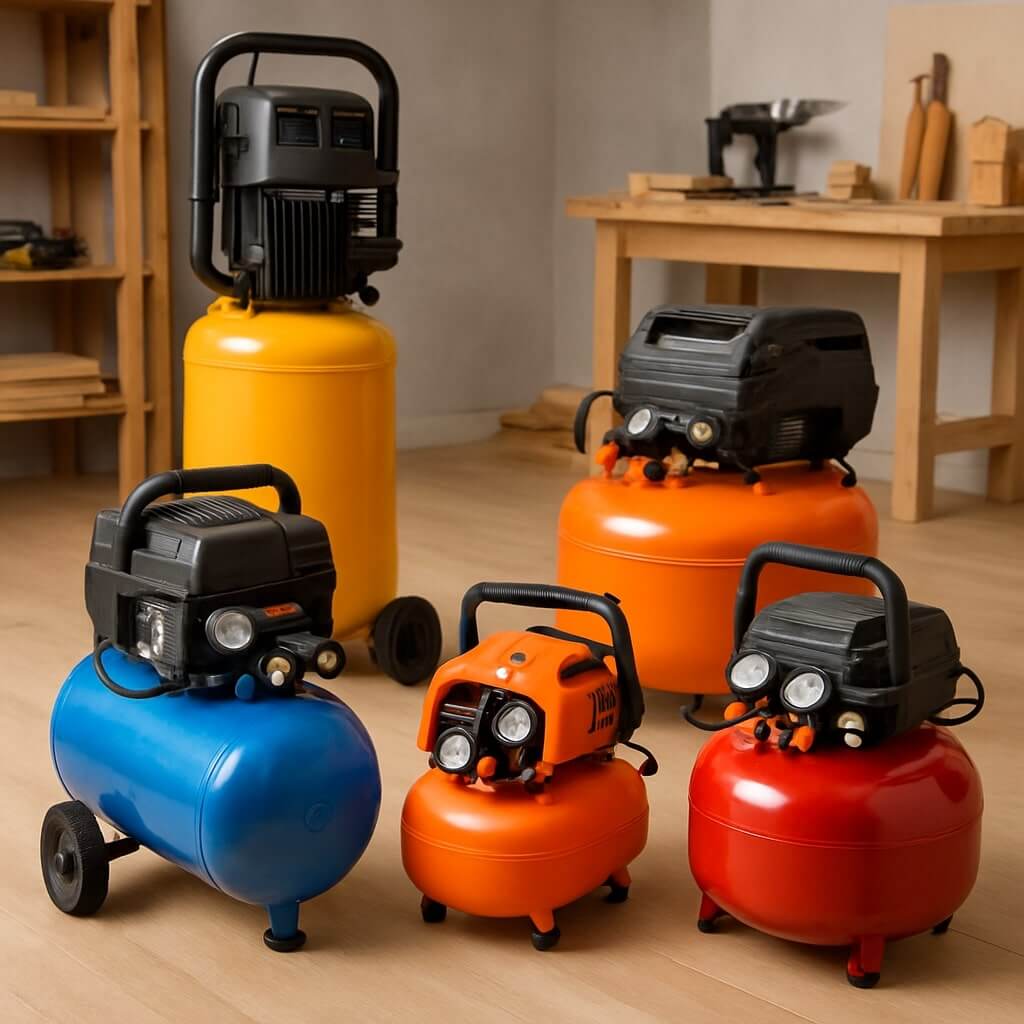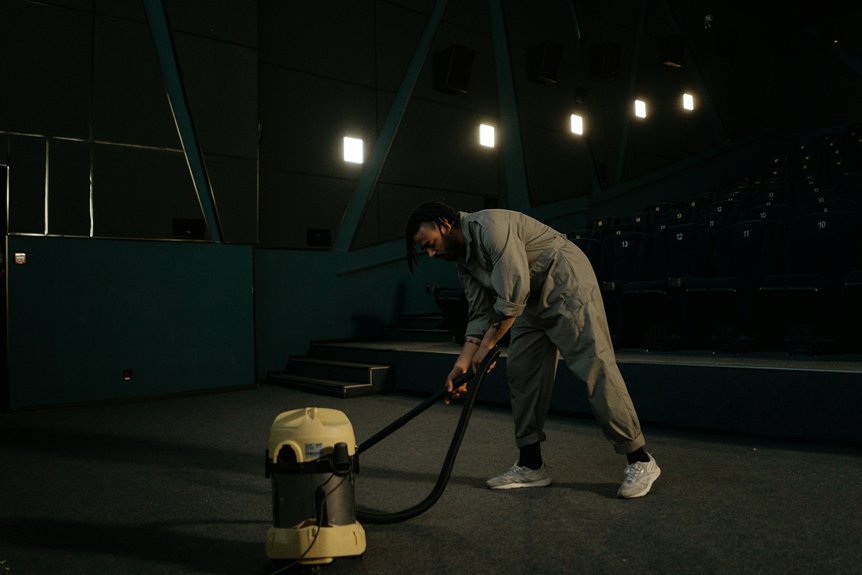When tackling DIY projects around the home, having the right compressor can make all the difference. You’ll want to evaluate factors like power, tank size, and portability to find a model that suits your needs. Whether you’re inflating tires or powering tools, the ideal compressor can enhance your efficiency and performance. But with so many options available, how do you choose the best one for your projects? Let’s explore your options.
Key Takeaways
- Look for compressors with adequate PSI and CFM ratings to meet the demands of your DIY tools and projects.
- Portable models like DeWalt DCC020IB and BOSTITCH BTFP02012 are excellent for home maintenance tasks due to their lightweight design.
- Ensure regular maintenance, including cleaning and inspecting for leaks, to prolong the life and efficiency of your compressor.
- Consider safety precautions such as ventilation and appropriate gear when using compressors for tasks like painting or powering tools.
- Evaluate warranties and customer feedback to ensure you select a reliable compressor that offers good long-term value for your DIY needs.
Understanding the Importance of a Home Maintenance Compressor

When you think about keeping your home in top shape, a home maintenance compressor often doesn’t come to mind, yet it plays a crucial role in your toolkit.
This powerful device offers numerous compressor benefits, enhancing your maintenance efficiency. With a compressor, you can easily inflate tires, power pneumatic tools, and even clean hard-to-reach areas.
It saves you time and effort, making DIY projects manageable. By incorporating a compressor into your routine, you’ll tackle home repairs and maintenance tasks with greater ease, ensuring your home remains in excellent condition without the hassle.
Don’t overlook this essential tool in your home maintenance arsenal!
Key Features to Look for in a Compressor
When you’re choosing a compressor for home maintenance, pay attention to power and pressure ratings to guarantee it meets your needs.
Tank size and portability are also essential, especially if you plan to move it around or use it for various tasks.
Knowing these key features will help you make an informed decision that suits your projects.
Power and Pressure Ratings
Understanding power and pressure ratings is essential for choosing the right compressor for your home maintenance tasks.
These ratings determine how effectively your compressor will perform, especially with various compressor types. Here are key factors to take into account:
- Horsepower (HP): Higher HP typically means more power for demanding tasks.
- PSI (Pounds per Square Inch): Look for a compressor that meets the pressure requirements of your tools.
- CFM (Cubic Feet per Minute): Confirm the CFM rating aligns with your pressure gauges for peak performance.
Choosing wisely can enhance your DIY projects and save you time and effort!
Tank Size and Portability
Selecting the right compressor doesn’t just stop at power and pressure ratings; tank size and portability are also vital features to evaluate.
The tank capacity plays an important role in how long you can run your tools without interruption. If you’re tackling larger projects, opt for a compressor with a bigger tank.
On the other hand, consider portability options if you need to move it around frequently. Lightweight models or those with wheels can make your DIY tasks much easier.
Balancing tank size with portability guarantees you’ll have the right compressor for any project, big or small.
Top Recommendations for Portable Compressors
If you’re looking to tackle various home maintenance tasks efficiently, a portable compressor can be a game-changer.
Here are three top recommendations that balance performance, noise levels, and trusted compressor brands:
- DeWalt DCC020IB – Known for its compact size and low noise levels, it’s perfect for indoor tasks.
- Makita MAC2400 – This model boasts a powerful motor and operates quietly, making it ideal for residential use.
- BOSTITCH BTFP02012 – Lightweight and portable, it offers impressive airflow with minimal noise, perfect for DIY projects.
Choose any of these, and you’ll be well-equipped for your home maintenance needs!
Best Stationary Compressors for Home Use
When it comes to tackling larger home projects, investing in a stationary compressor can greatly enhance your efficiency and productivity. There are various stationary compressor types, including belt-driven and direct-driven models, each suited for different tasks.
| Compressor Type | CFM Rating | Ideal Use |
|---|---|---|
| Belt-Driven | 10-20 CFM | Continuous operation |
| Direct-Driven | 5-10 CFM | Light to moderate tasks |
| Oil-Free | 4-6 CFM | Indoor use |
| Portable Stationary | 6-10 CFM | Occasional use |
For best results, follow these compressor installation tips to guarantee proper setup and performance.
Versatile Compressors for Multiple Applications
While stationary compressors excel in larger projects, versatile compressors offer the flexibility you need for a variety of tasks around the home.
These compact units can handle numerous applications, making them ideal for DIY enthusiasts. Here are three ways you can use them:
- Airbrush Painting: Perfect for artists, they provide consistent airflow for smooth finishes on your projects.
- Tire Inflation: Quickly inflate car or bike tires without the hassle of manual pumps.
- Nail Guns: Effortlessly power your nailer for home improvement tasks.
With a versatile compressor, you’re well-equipped for any DIY challenge that comes your way!
Choosing the Right Size and Power for Your Needs
When choosing a compressor, it’s essential to take into account both size and power to match your specific needs.
Think about the DIY projects you plan to tackle and the tools you’ll be using, as this will help you determine the right specifications.
Compressor Size Considerations
Choosing the right size and power for your home maintenance compressor is crucial for tackling various tasks efficiently.
Consider the following factors when selecting:
- Compressor Types: Know whether you need a portable, pancake, or twin-stack compressor based on your projects.
- Airflow Requirements: Determine the CFM (Cubic Feet per Minute) needed for your tools to operate effectively.
- Duty Cycle: Understand how long you’ll be using the compressor; continuous use requires a higher-capacity model.
Research reputable compressor brands to guarantee reliability and performance.
Power Requirements Explained
Understanding power requirements is essential for selecting the right compressor for your home maintenance tasks. You’ll need to evaluate the power source—electric or gas—and how it impacts energy efficiency. Here’s a quick overview:
| Power Source | Typical Voltage | Energy Efficiency |
|---|---|---|
| Electric | 120V | High |
| Electric | 240V | Very High |
| Gas | N/A | Moderate |
| Battery | 18V-60V | Variable |
| Dual Fuel | 120V/240V | High |
Common DIY Applications
Selecting the right size and power for your compressor depends largely on the DIY tasks you plan to tackle around your home.
Consider these common applications:
- Spray Painting: For smooth finishes, choose a compressor with at least 2.0 CFM at 40 PSI.
- Tire Inflation: A portable compressor with 1.0 CFM at 90 PSI works well for quick tire inflation.
- Nail Guns: Use a compressor with a minimum of 2.5 CFM at 90 PSI for efficient nailing.
Maintenance Tips for Longevity and Performance
To guarantee your home maintenance compressor runs efficiently and lasts for years, regular upkeep is essential.
Regular upkeep is crucial for your home maintenance compressor to ensure efficiency and longevity.
Start by maintaining cleanliness; wipe down your compressor after each use to remove dust and debris.
Make it a habit to perform regular inspections, checking for leaks, loose connections, and wear on hoses.
Change the oil as recommended by the manufacturer and drain moisture from the tank to prevent rust.
Additionally, verify the air filter is clean to maintain peak airflow.
Safety Considerations When Using Compressors
While using a compressor can make your home projects easier, it’s vital to prioritize safety to prevent accidents and injuries.
Here are three key compressor safety tips you should follow:
- Wear Personal Protective Equipment: Always use safety goggles, ear protection, and gloves to shield yourself from debris and noise.
- Inspect Your Equipment: Regularly check hoses, fittings, and the compressor itself for wear and tear to avoid malfunctions.
- Maintain Proper Ventilation: Confirm you’re working in a well-ventilated space to prevent the build-up of harmful fumes, especially when using paint sprayers.
Comparing Prices and Warranty Options

After guaranteeing safety while using your compressor, it’s time to contemplate the financial aspects of your investment.
Start with a price comparison to find a model that fits your budget without sacrificing quality. Don’t just settle for the first option—check multiple retailers and online platforms for the best deals.
Next, perform a warranty analysis; a longer warranty often indicates a manufacturer’s confidence in their product. Look for compressors offering at least a one-year warranty, as this can save you money on repairs.
A longer warranty reflects manufacturer confidence; aim for at least a one-year warranty to save on future repairs.
Balancing price and warranty will guarantee you make a smart, long-lasting purchase for your DIY projects.
Conclusion
To sum up, choosing the right home maintenance compressor can make your DIY projects smoother and more efficient. By considering key features like power, tank size, and portability, you’ll find the perfect fit for your needs. Regular maintenance and safety precautions will guarantee your compressor lasts longer and performs better. So, whether you’re tackling small repairs or larger improvements, investing in a quality compressor is a smart move that’ll pay off in the long run.




